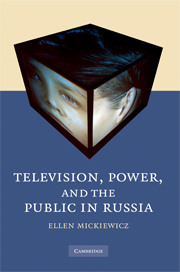Book contents
- Frontmatter
- Contents
- List of figures
- Preface
- Chapter 1 The missing term in the equation
- Chapter 2 Detecting channels
- Chapter 3 Election news and angry viewers
- Chapter 4 Excavating concealed tradeoffs
- Chapter 5 Soviet Television: russian memories
- Chapter 6 Endings
- Chapter 7 The other side of the screen
- Index
Chapter 2 - Detecting channels
Published online by Cambridge University Press: 22 September 2009
- Frontmatter
- Contents
- List of figures
- Preface
- Chapter 1 The missing term in the equation
- Chapter 2 Detecting channels
- Chapter 3 Election news and angry viewers
- Chapter 4 Excavating concealed tradeoffs
- Chapter 5 Soviet Television: russian memories
- Chapter 6 Endings
- Chapter 7 The other side of the screen
- Index
Summary
In the United States, for many years after television was introduced, the individual channel had little meaning for the audience: it was the program that was branded. Viewers would be unlikely to say, “let's watch NBC,” or “let's tune in to CBS.” Later, niche television was both a response to and a source for fragmenting the public by precisely targeting preferences with cable, satellite, and the Internet. The palette of the news among the “Big Three” networks (CBS, NBC, ABC) when they dominated the television scene – especially the news – differed little in choice and positioning of stories. Perhaps it was only in the lightweight last story, presented as an audience-pleaser to keep viewers from changing the channel, that there might be some trivial difference. The original “Big Three” networks were sold and folded into large conglomerates where news was a very minor part of the product mix. Yet viewers' choices were still based on the program and not on the owners. Did viewers express their preferences when choosing Disney, General Electric (GE), Time-Warner, or other owners? Programs, music, films, and the rest could emerge from any platform and be transmitted by a range of people from seasoned journalists to bloggers.
Russian viewers follow a decidedly different strategy, in which knowledge of a station and a station's owners may be vital in deciphering what is meant to be a persuasive agenda.
- Type
- Chapter
- Information
- Television, Power, and the Public in Russia , pp. 41 - 59Publisher: Cambridge University PressPrint publication year: 2008

